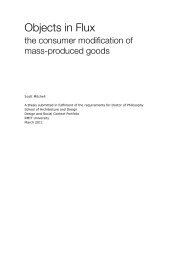Making Memory Space: Recollection and Reconciliation in Post ...
Making Memory Space: Recollection and Reconciliation in Post ...
Making Memory Space: Recollection and Reconciliation in Post ...
Create successful ePaper yourself
Turn your PDF publications into a flip-book with our unique Google optimized e-Paper software.
Lynn Meskell highlights the latent difficulty <strong>in</strong> this selective approach to construct<strong>in</strong>g the past. She<br />
presents the possibility that the ‘larger edifice of forgett<strong>in</strong>g will elide the specificities of a history that<br />
can still to a large degree be documented <strong>and</strong> told <strong>and</strong> <strong>in</strong> the process the <strong>in</strong>gra<strong>in</strong>ed effects of<br />
colonialism will be naturalised <strong>and</strong> their didactic fictions will reta<strong>in</strong> their residual power’. 54 She<br />
comments that <strong>in</strong> the desire to forge a ra<strong>in</strong>bow nation, founded on tolerance <strong>and</strong> openness, it is<br />
possible to expunge an uglier <strong>and</strong> sometimes more truthful recollection of the past. In so do<strong>in</strong>g South<br />
Africa runs the risk of construct<strong>in</strong>g an empty narrative, one that dismisses the specifics of its past <strong>in</strong><br />
favour of a generalised future. The cost of this version of the past (accord<strong>in</strong>g to Meskell) is the<br />
creation of a history based <strong>in</strong> fabrication, where Jan Van Riebeck becomes the orig<strong>in</strong>al father of South<br />
Africa, so that – ironically - <strong>in</strong>digenous constituencies celebrate their own oppression. The demonis<strong>in</strong>g<br />
of one specific aspect of the past allows for the rest of the past to be reconsidered <strong>in</strong> a new light.<br />
In addition to dom<strong>in</strong>ant memory, which is often expressed as collective memory, marg<strong>in</strong>alised or<br />
peripheral memories must also still exist. Often these personal accounts differ from the official<br />
narrative or <strong>in</strong>clude aspects of the past that have been allowed to recede. These ‘counter-memories’<br />
or anti-memorials subsist <strong>in</strong> private spaces <strong>and</strong> <strong>in</strong>dividual m<strong>in</strong>ds challeng<strong>in</strong>g the status quo. 55 Some<br />
contemporary memory space <strong>in</strong> South Africa is attempt<strong>in</strong>g to <strong>in</strong>clude some of the qualities of the anti-<br />
memorial, such as their fluidity <strong>and</strong> spontaneity <strong>and</strong> most significantly, their <strong>in</strong>tegration <strong>in</strong>to daily life, to<br />
generate a less overtly official type of civic space. The Red Location Museum <strong>in</strong> Chapter Five is a<br />
particular example of this. However, the potency of memory lies <strong>in</strong> its shared commonality, which, by<br />
virtue of that commonality becomes the dom<strong>in</strong>ant narrative. As architecture reflects a common<br />
narrative, it becomes an embodiment of the collective recollection <strong>and</strong> <strong>in</strong> so do<strong>in</strong>g assumes the status<br />
of a sanctioned memorial.<br />
<strong>Memory</strong> space - museums <strong>and</strong> memorials<br />
Memorials <strong>and</strong> museums are traditionally considered dist<strong>in</strong>ct from one another: museums operate as<br />
receptacles for memory whereas memorials serve as symbols of historic events. 56 Memorials are often<br />
generated from sites of significance, which are considered to have an <strong>in</strong>herent authenticity <strong>in</strong><br />
themselves <strong>and</strong> form a natural marker of past events, serv<strong>in</strong>g as a bastion of recollection. Museums<br />
often become sites of significance, where their role as conta<strong>in</strong>er of memory allows for the build<strong>in</strong>g to<br />
become an icon with<strong>in</strong> a city, as exemplified by The Jewish Museum <strong>in</strong> Berl<strong>in</strong> or the Tjibaou Cultural<br />
Centre <strong>in</strong> New Caledonia. Traditionally museums, particularly those seek<strong>in</strong>g to reflect history, have<br />
long attempted to relay the past <strong>in</strong> terms of a conta<strong>in</strong>ed narrative. In many respects however,<br />
contemporary museums are becom<strong>in</strong>g a form of memorial. Architectural form, <strong>in</strong> comb<strong>in</strong>ation with the<br />
54 Lynn Meskell, Op cit, p.159.<br />
55 Sueanne Ware, Anti-Memorials: Re-th<strong>in</strong>k<strong>in</strong>g the L<strong>and</strong>scape of <strong>Memory</strong> (PhD: RMIT University, 2005), p.2.<br />
56 While memorial can also <strong>in</strong>clude many other forms of memory practice as discussed by for the purposes of this discussion it is<br />
conf<strong>in</strong>ed to exam<strong>in</strong>ation of built form.<br />
24
















